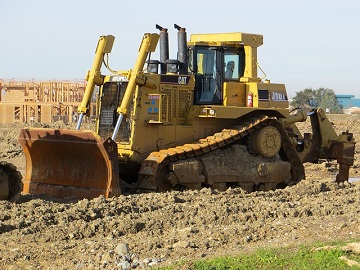How to manage construction plant
The term ‘plant’ refers to machinery, equipment or apparatus used for an industrial activity. Typically, in construction, ‘plant’ refers to heavy machinery and equipment used during construction works. Many construction companies fail to manage plant efficiently, despite the fact that it represents one of their biggest costs.
Construction plant is generally re-useable, and so, as well as being purchased new, it may be purchased second hand or hired. Rented vehicles tend to be newer, and so better maintained, more reliable, and equipped with more up-to-date features. By renting plant, companies are also able to scale their fleet size up or down relatively flexibly.
For more information, see Plant acquisition.
Accounting software for construction management often features plant management modules. This can enable plant to be assigned efficiently, by listing plant and their relevant details, including availability. Relevant staff are then able to determine the availability of plant at any given time. This is particularly useful for larger companies who may have several projects in progress simultaneously and need to be able to maximise their fleet’s utility.
By using such software to manage plant, it is also possible to monitor variable and fixed costs associated with insurance, storage, operation and depreciation.The actual costs of each contract can be easier to understand if plant costs are automatically associated with the relevant works in the accounts system. Rising costs are also easier to detect and monitor, and can help a company make informed decisions about managing the fleet, i.e. replacing an older vehicle that has had large repair bills.
Maintaining plant effectively and safely is a legal requirement, but it is also beneficial in terms of reducing costs. Management of plant involves identifying hazards for each item and having a plan for how they can be avoided through maintenance and regular inspections.
Accounting software can assist with highlighting the most appropriate time, i.e. during downtime, that an item of plant could undergo maintenance. This is useful in terms of forward planning projects that may need to use the item on-site, and scheduling specialist contractors that may be required for maintenance purposes.
Increasingly, construction companies have been exploring the opportunities of the Internet of Things (IoT) for plant management. For example, Caterpillar have begun manufacturing plant items with sensors and other connected devices, with the aim of establishing completely digitised and data-driven fleets.
Some of the plant management benefits of using IoT include:
- Accurate measurement of engine load, fluid temperature and pressure, idle time, fuel consumption, etc.
- Identifying operators who may be using plant incorrectly and require retraining, e.g. using excessive fuel.
- Generating data relating to machine performance and efficiency, allowing managers to reduce energy consumption and increase productivity.
- Giving a more accurate picture of when and how plant is used..
- Better predictability of when the plant is likely to require maintenance.
- Plant performance can be tracked in real time, highlighting areas not running to their full capacity.
- Plant can be tracked, helping to prevent theft and misuse.
- Alerts relating to the location of plant can be sent to workers on-site, improving their awareness and so safety.
- Automatic ordering of replacement parts as and when required.
- Accurate monitoring of site noise and vibration compliance.
[edit] Find out more
[edit] Related articles on Designing Buildings Wiki
- Activity schedule.
- Construction inventory management.
- Construction plant.
- Construction tools.
- Contractor’s master programme.
- Internet of things.
- Logistics management.
- Material handling.
- Planned preventive maintenance.
- Plant acquisition.
- Programme for building design and construction.
- Project manager.
- Resource management.
- Scheduling construction activities.
- Time management of construction projects.
- Wheel washing system.
Featured articles and news
The UK's Modern Industrial Strategy: A 10 year plan
Previous consultation criticism, current key elements and general support with some persisting reservations.
Building Safety Regulator reforms
New roles, new staff and a new fast track service pave the way for a single construction regulator.
Architectural Technologist CPDs and Communications
CIAT CPD… and how you can do it!
Cooling centres and cool spaces
Managing extreme heat in cities by directing the public to places for heat stress relief and water sources.
Winter gardens: A brief history and warm variations
Extending the season with glass in different forms and terms.
Restoring Great Yarmouth's Winter Gardens
Transforming one of the least sustainable constructions imaginable.
Construction Skills Mission Board launch sector drive
Newly formed government and industry collaboration set strategy for recruiting an additional 100,000 construction workers a year.
New Architects Code comes into effect in September 2025
ARB Architects Code of Conduct and Practice available with ongoing consultation regarding guidance.
Welsh Skills Body (Medr) launches ambitious plan
The new skills body brings together funding and regulation of tertiary education and research for the devolved nation.
Paul Gandy FCIOB announced as next CIOB President
Former Tilbury Douglas CEO takes helm.
UK Infrastructure: A 10 Year Strategy. In brief with reactions
With the National Infrastructure and Service Transformation Authority (NISTA).
Ebenezer Howard: inventor of the garden city. Book review.
The Grenfell Tower fire, eight years on
A time to pause and reflect as Dubai tower block fire reported just before anniversary.
Airtightness Topic Guide BSRIA TG 27/2025
Explaining the basics of airtightness, what it is, why it's important, when it's required and how it's carried out.
Construction contract awards hit lowest point of 2025
Plummeting for second consecutive month, intensifying concerns for housing and infrastructure goals.
Understanding Mental Health in the Built Environment 2025
Examining the state of mental health in construction, shedding light on levels of stress, anxiety and depression.
The benefits of engaging with insulation manufacturers
When considering ground floor constructions.
Lighting Industry endorses Blueprint for Electrification
The Lighting Industry Association fully supports the ECA Blueprint as a timely, urgent call to action.
























